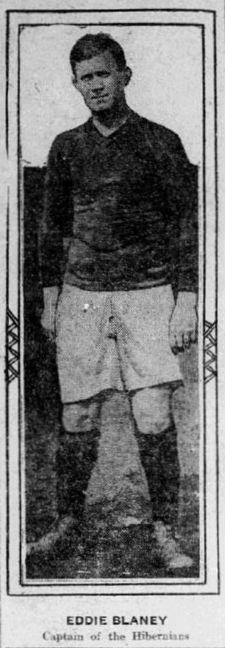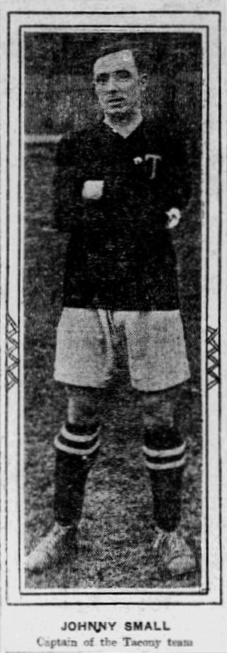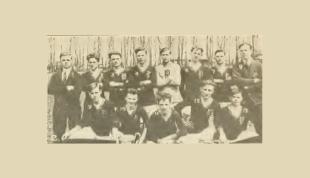Photo: Putnam FC, 1913-14
Our series on Philadelphia soccer happenings one hundred years ago continues
Tacony vs. Hibernian in American Cup semifinal
On March 21, 1914, in front of some 3,000 spectators at Tacony Ball Park at State Road and Unruh Street, Tacony defeated Philadelphia Hibernian 4-1 in the semifinal of the American Cup. It was a crushing defeat for the Hibs, who had lost the 1911 final to Rhode Island’s Howard & Bullough and been eliminated from the 1913 semifinals by Tacony, the Inquirer reporting on March 22, “Never before in the history of the Hibernians have they been so completely outclassed,” adding “it is a question if any defense in the country could have successfully withstood the onslaught of the Tacony frontliners in the second half.”
 Hibernian’s Tommy Swords opened the scoring following a corner kick. Some 18 minutes later, Tacony equalized and the scoreline was level at the half. After that, it was all Tacony. Eight minutes after the start of the second half, center halfback Brown, who had scored the equalizer, put Tacony in the lead. A third goal came from a penalty kick after a Hibernian player handled the ball in the box. Soon after, outside left Hartwell made it 4-1.
Hibernian’s Tommy Swords opened the scoring following a corner kick. Some 18 minutes later, Tacony equalized and the scoreline was level at the half. After that, it was all Tacony. Eight minutes after the start of the second half, center halfback Brown, who had scored the equalizer, put Tacony in the lead. A third goal came from a penalty kick after a Hibernian player handled the ball in the box. Soon after, outside left Hartwell made it 4-1.
For Tacony, who won the 1910 American Cup, it would be their second consecutive American Cup final appearance after losing to Patterson in the 1913 final. Just who they would face remained to be seen as the semifinal match between Jersey AC and Bethlehem, scheduled to take place in Jersey City on March 22, was postponed until the following weekend because the pitch, the Inquirer reported on March 23, was “inches deep in snow and slush.”
Final Philadelphia team knocked out of inaugural National Challenge Cup
Philadelphia’s participation in the inaugural National Challenge Cup, known today as the US Open Cup, came to end on March 21, 1914 with Peabody FC’s 4-1 road loss in the tournament quarterfinals to New Bedford in Massachusetts.
When the quarterfinal draw was made, Peabody was selected as the home team. With home field advantage, the Inquirer to reported on Feb. 16 that “it would not be in the least be surprising” if Peabody made it to the semifinals. However, in a scenario familiar to followers of recent US Open Cup tournaments, Oliver Hemingway reported in the 1914-15 Spalding Guide, that “for a consideration, Peabody agreed to stage the game in New Bedford.”
In front of “a crowd of 3500 enthusiasts,” the Inquirer match report on March 22 said, “The Philadelphians started off like winners.” Unable to capitalize on their strong start, Peabody found themselves trailing 2-0 to New Bedford at the half. The resumption of play saw the home team score two more quick goals. The Inquirer reported that Peabody “never gave up” and “persistent attacks” resulted in a consolation goal before the final whistle brought a close to both the 4–1 quarterfinal contest and Philadelphia’s run in the first US Open Cup.
Allied Amateur Cup
Four Allied Amateur Cup tournament were played on March 21, 1914. In second round play at Third and Lehigh, the American League’s Philadelphia Electrics, as the Inquirer reported on March 23, “upset the dope” in easily defeating Allied first division side Reading, 5-2. After weeks of adverse winter weather had wreaked havoc on area soccer fields, the Inquirer’s March 22 match report noted, “The ground was in fairly good condition, although soft at the Third street end, and a remarkably good crowd was in attendance in spite of the counter attraction at Tacony Ball Park.” The Inquirer’s March 23 report said of the winners, “Even with some of the so-called ‘has beens’ in their ranks, the Philadelphia Electrics size up on a level with any other team in the amateur ranks. In fact, they are the best team in the city and should not have much difficulty in winning their way to the final round of the Amateur Cup, providing the players stick to their training.”
 At Washington Park, located at 26th and Allegheny, Allied second division side Putnam brushed aside Allied first division side Smith AA in a 4-0 second round upset. Kensington defeated fellow Allied first division side Falls, 2-1 in another second round game. In third round play at 44th and Parkside, Allied first division side West Philadelphia held on to defeat Wanderers 3-2. The Inquirer reported on March 22, The Wanderers put up a splendid game against their more experienced opponents, and emerged from the contest with a considerable amount of credit.”
At Washington Park, located at 26th and Allegheny, Allied second division side Putnam brushed aside Allied first division side Smith AA in a 4-0 second round upset. Kensington defeated fellow Allied first division side Falls, 2-1 in another second round game. In third round play at 44th and Parkside, Allied first division side West Philadelphia held on to defeat Wanderers 3-2. The Inquirer reported on March 22, The Wanderers put up a splendid game against their more experienced opponents, and emerged from the contest with a considerable amount of credit.”
League play
Despite teams playing Allied Amateur Cup games, league play continued. In the Allied first division, Bethlehem easily defeated 4-1 Disston at home at “a very heavy” East End Field. The Bethlehem eleven included only four regular starters. In the Allied third division, Centenary made short work of Puritan in a 6-2 victory.
Two American League games were played. While Rangers arrived to face Whitehall Rovers with only ten men, they nevertheless prevailed 3-2. Each team saw a player sent off “for engaging in fisticuffs.” Victor Athletic defeated Frankford Boys’ Club, 4-2, in what the Inquirer described as “a well-played and interesting match.”
Throughout the 1913-14 season, the United League had shown itself to be the city’s home for goalfests. March 21, 1914 proved to be no different as the days two matches resulted in 14 goals scored. At Front and Erie, Kensington Boys’ Club Reserves defeated Vincome, 6-0. The American Pulley Company also scored six goals in its victory while allowing two to home side Cardington.
English pro teams coming
On March 22, 1914, the Inquirer reported on the news that two unnamed English professional teams would be touring the US and Canada in 1915. “The plans have been agreed to by the English Football Association who will have charge of the tour and the selecting of the teams, and the games will be played in all of the principal cities in this country and Canada,” said the report, which continued,
This will be the first occasion that two English elevens have toured this country at the same time, as as it is the intention of those responsible for the project to have the teams playing against each other at least one match in every city they will visit it will give those who have never witnesses the game in England a splendid opportunity to see two first class teams in action and, incidentally, witness all the fine points of the game being brought out by experienced players.
Noting that previous tours by English teams had come in the form of amateur sides such as The Pilgrims and Corinthians, the Inquirer said, “it is recognized that the professionals have the game down better than their amateur brethren, and in consequence the finer points down more forcibly.”
In the same report, the Inquirer noted local objections to the appointment of United States of America Football Association president Dr. Randolph Manning to the US Olympic Commission ahead of the 1916 Olympic Games in Berlin. Leaders of Philadelphia’s United League were not happy with the appointment because Manning was not a native born American. The Inquirer reported, “They claim that as long as the rules laid down for the Olympic games stipulate that none but American born or naturalized citizens are eligible to represent this country in the games, that the committee should also be composed of such.” Born in England, Manning had been educated in Germany, where he was involved in the founding of the Deutscher Fussball Bund, before emigrating to the US in 1906.
The beginning of the First World War in Europe five months after the Inquirer report would render both stories moot.



Comments